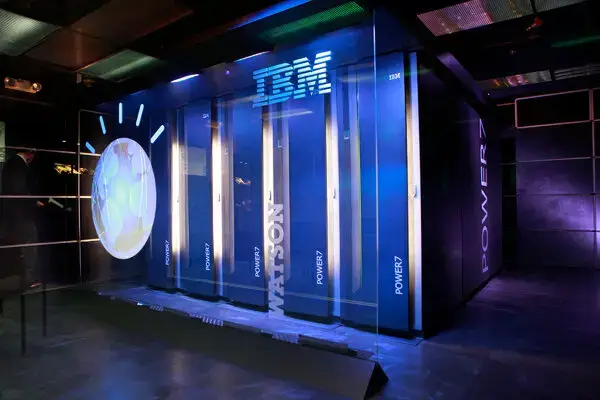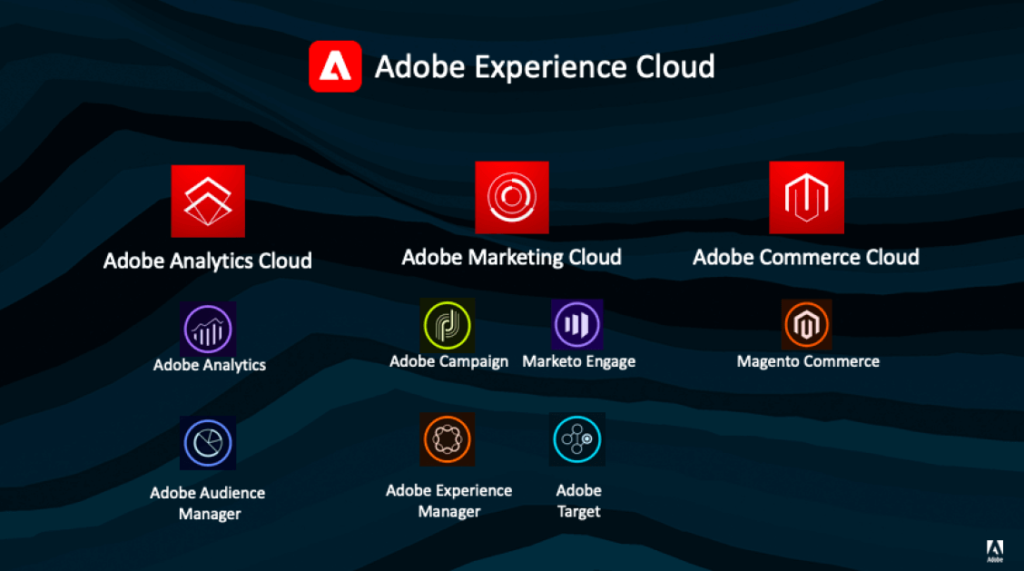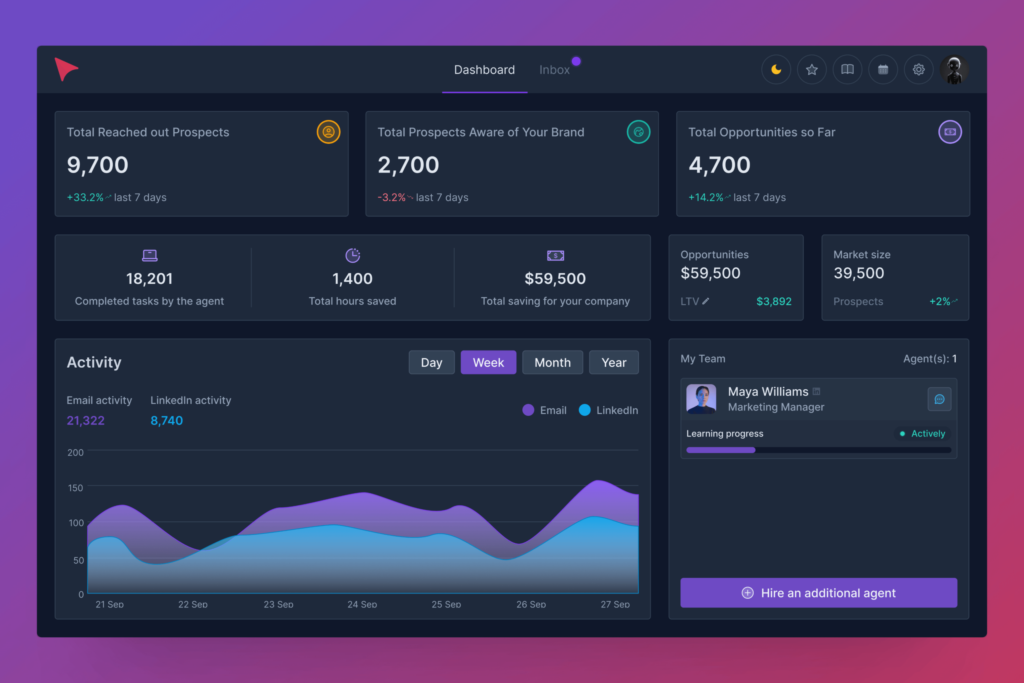Lead generation done well is still essential to B2B marketing success in the cutthroat business world of today. Though conventional techniques have worked effectively in the past, the use of artificial intelligence (AI) has completely changed the dynamics of B2B lead generation by providing previously unheard-of levels of accuracy and effectiveness.
AI clearly works well at simplifying lead generating procedures; several companies have seen notable increases in lead quality and conversion rates. In the B2B market, where sales cycles are longer and the purchasing process is more complex, AI technologies enable businesses to automate complicated operations, extract insights from huge datasets, and provide individualized experiences at scale.
This blog explores the field of AI-enabled B2B lead generation and offers a thorough manual on how companies may use AI to improve their lead generation plans. You will see at the end why AI-driven B2B lead generation is best served by tool like AnyBiz.
Understanding B2B Leads
Building successful lead generating plans in the business world requires a grasp of the characteristics of B2B (business-to-business) leads. B2B leads are prospective clients who are commercial entities—companies that are looking to buy products or services from other companies. With business-to-consumer (B2C) leads, where individual customers are the target prospects, this is very different.
Differences Between B2B and B2C Leads
- Decision-Making Process. B2B transactions usually entail a longer and more complicated decision-making process that frequently calls for clearance from several levels inside an organization. Generally speaking, B2C decisions are made by individuals and can be more impulsive.
- Sales Cycle Length. Generally speaking, B2B sales cycles are longer than B2C cycles because of the intricacy and greater stakes of their transactions.
- Relationship Building. Long-term interactions and professional trust are the main priorities in the development of B2B relationships. Relationships with consumers may not need as much in-depth or continuous communication.
- Value of Transactions. Because of the size and complexity of business requirements, B2B sales frequently have a larger value per transaction than do B2C sales.
Want to know more? Read also – B2C Lead Generation with AI: Best Strategies & Examples
Importance of Quality Over Quantity
It is impossible to stress in B2B lead generation the need of quality over quantity. If a lot of leads are not turned into sales, then producing a lot of leads is not as beneficial. The resources put into each possible sale in B2B make the consequences of pursuing the incorrect leads more serious. High-quality leads are those that have the interest and the power to make purchases and are therefore most likely to become paying clients.
Therefore, the main focus of successful B2B lead generating tactics is on finding and interacting with top prospects who show a sincere desire for the supplied good or service.
Key Players in B2B Lead Generation
Coordination of the activities of several stakeholders inside a company is necessary for successful B2B lead creation. Every one of them contributes uniquely to making sure that the lead generating process not only attracts prospective customers but also guides them toward profitable conversions. To maximize any B2B lead generating approach, one must understand these roles.
Typical Stakeholders Involved
- Marketing Teams. These experts are in the forefront of lead generating, creating and carrying out marketing plans that draw in prospective prospects. They do content production, oversee marketing initiatives, and use market data analysis to pinpoint target audiences.
- Sales Professionals. Sales teams take over after leads are produced. Engaging these prospects, learning about their needs, and guiding them through the sales process is their duty. Deals are closed, conversations take place, and thorough demonstrations are frequently part of this.
- Experts in digital tools and platforms, digital strategists make sure that the online elements of lead generating initiatives work. To gather leads through digital channels, they run SEO campaigns, manage websites, and run online advertising.
- Data analysts are those who examine information from sales and marketing activities in order to assess the efficacy of various tactics and to improve methods according to actual results.
- Customer Service Representatives. Often disregarded in the process of generating leads, these folks are essential to keeping prospective leads happy and involved, particularly as the sales funnel progresses.
- IT professionals. They guarantee that the technical infrastructure—websites, CRM systems, marketing automation tools—works well and melds together across many platforms, therefore promoting lead generation.
Role of AI and Automation Tools in Supporting These Stakeholders
- AI can automate content delivery at the best times, tailor marketing campaigns based on lead behavior and preferences, and offer insights into campaign performance for marketing teams.
- For sales professionals, artificial intelligence (AI) solutions can assist with lead scoring, ranking leads according to their chance of conversion. Detailed lead profiles and behavior forecasts made possible by AI-driven analytics enable more customized and successful sales pitches for sales teams.
- Digital strategists can concentrate on strategy rather than the details of data management when they use automation technologies to simplify complicated chores like A/B testing, SEO monitoring, and web traffic analysis.
- For Data Analysts. By spotting patterns and trends that human analysts might miss, AI improves data analysis capabilities and makes more precise forecasts regarding the success of lead creation.
- Customer service representatives can spend more time addressing more complicated problems and fostering relationships with customers when AI chatbots and automated response systems handle simple questions and interactions.
- For IT professionals, automation can facilitate the management of the wide range of lead generating tools and technologies, including software updates, patch deployment, and integrating new tools into the current infrastructure.
B2B Lead Generation Process
Finding and turning potential companies into clients is done methodically through the B2B lead generating process. It entails a number of crucial phases, each designed to guarantee that the leads produced are not only many but also of excellent quality and likely to lead to successful commercial contacts. Every one of these processes is made more efficient and effective by the incorporation of AI technologies.
Stages of the B2B Lead Generation Lifecycle:
1. Target Market Identification
- This phase entails identifying your target clientele according to a number of factors, including industry, size, geography, and needs of the organization.
- Integration of AI. Human analysts may miss patterns and trends that AI may find by analyzing enormous volumes of data. Over time, machine learning models can also forecast which market niches will be most open to your goods or services, therefore focusing your target market.
2. Lead Capture Techniques
- Target market identification is the first step in capturing leads through websites, social media, webinars, trade events, and direct outreach.
- AI Integration. Visitors to websites and social media can be engaged around-the-clock by AI-powered chatbots, which can also gather data and respond to questions to provide leads. Where and when advertisements should be placed can also be optimized by AI to maximize exposure and interaction.
3. Lead Qualification Criteria
- Not all leads captured are ready or suitable for a sale. Lead qualification involves applying specific criteria to determine a lead’s potential to become a customer, based on factors like their need for your product, budget, authority, and buying timeline.
- AI Integration. AI can swiftly analyze lead data to score and rank leads according to their likelihood to convert. This helps in prioritizing efforts on high-value prospects.
4. Conversion Strategies
- This final stage involves converting qualified leads into paying customers through direct sales efforts, including personalized emails, product demos, and negotiation tactics.
- AI Integration. AI can tailor communication to match the lead’s profile, creating highly personalized outreach that addresses specific needs and pain points. Predictive analytics can suggest the most effective times for contact and the best strategies for closing the sale.
Enhancing Efficiency with AI
AI not only automates many of the mechanical tasks associated with each stage but also brings a level of analytical sophistication that can adapt and evolve with market conditions. For instance, AI systems can continually learn from interactions and outcomes, using this knowledge to improve strategies in real-time. This capability means that B2B lead generation processes become more intelligent and refined, increasing the return on investment in marketing and sales activities.
10 AI Proven Strategies for Growth in B2B Lead Generation
1. AI-driven predictive analytics for identifying target demographics
Predictive analytics powered by AI completely changes how companies find and focus on the most profitable B2B marketing segments. Employing sophisticated algorithms, businesses can examine past data and spot trends that can point to possible consumer interest and purchasing behavior. More accurate targeting made possible by this approach increases conversion rates and makes better use of marketing resources. Studies indicate that businesses using predictive analytics can increase the success of their marketing initiatives by up to 20–30%.
Step-by-step Implementation:
- Gather comprehensive data from sources like CRM systems, website interactions, past campaigns, and third-party data providers.
- Integrate and consolidate the collected data into a unified analytics platform.
- Develop predictive models using machine learning algorithms to analyze the data and identify significant patterns and trends.
- Use the insights from the predictive models to identify the demographics most likely to convert into customers.
- Launch small-scale test campaigns to the identified demographics to refine predictions and model accuracy.
- Roll out full-scale marketing campaigns focused on the validated demographics once testing confirms the effectiveness of the targeting.
- Continuously feed new data back into the model to refine and improve the targeting accuracy over time.
2. Chatbots for 24/7 Lead Capture and Initial Engagement
For B2B companies, chatbots driven by AI are a priceless tool that offer lead capturing and round-the-clock interaction without the overhead of human employees. With seamless operation across several digital channels, these intelligent chatbots can answer questions, qualify leads, and even set up appointments. Lead generating can rise dramatically with chatbot implementation; data show that companies implementing AI chatbots find up to a 67% boost in lead engagement. Companies can guarantee no prospective lead is lost because of time or resource limitations by automating first contact.
Step-by-step Implementation:
- Determine the primary functions your chatbot needs to fulfill, such as answering FAQs, collecting lead information, or scheduling appointments.
- Select a chatbot platform that integrates easily with your existing technology stack and supports the required functionalities.
- Craft conversation scripts that guide users through predefined pathways, ensuring the chatbot can address common queries and capture necessary lead details.
- Connect the chatbot to your CRM system to automate data capture and lead tracking.
- Deploy the chatbot on your website and key digital platforms, then monitor interactions to identify areas for improvement.
- Use feedback and interaction data to refine chatbot responses and improve user engagement.
- Analyze the effectiveness of the chatbot in capturing leads and scale up its use across other platforms or for additional functionalities based on successful outcomes.
3. AI-powered Personalization of Communication
By customizing communications according to individual preferences, actions, and interaction history, AI-powered personalization revolutionizes how companies interact with their B2B leads. Personalized communications are more relevant and more well-received by receivers, hence this degree of customization greatly raises engagement and conversion rates. Customized email marketing have a sixfold higher transaction rate, according to statistics. Through real-time data analysis and application of insights made possible by AI, businesses can send messages that are not only relevant but also timely.
Step-by-step Implementation:
- From a variety of touchpoints, including website visits, email correspondence, and social media interactions, compile comprehensive information about your leads.
- Using AI technologies, divide your leads according to their needs, behaviors, sectors, and positions inside the organization.
- Develop content that is adapted to the requirements and interests of every group. Adapt messages dynamically based on the most recent interactions and data by using AI.
- Use AI-integrated marketing automation solutions to provide tailored communications when it’s most convenient.
- Monitor the way leads react to customized messages and modify tactics as needed.
- To increase the efficacy and relevancy of customized communications, update your AI algorithms often in response to fresh data and results.
- Using knowledge from first efforts, gradually expand personalization outside of email to additional channels like social media and direct messaging.
4. Use of AI in Content Generation to Attract Leads
By enabling B2B businesses to generate highly relevant and interesting content on a large scale, AI in content generation improves their capacity to draw in and convert leads. Businesses can produce material that is both search engine optimized and customised to the interests of their target audience by using AI technologies that examine current trends, keyword performance, and audience preferences. Website traffic and engagement can rise dramatically when AI-driven content creation is used; research indicates that engagement rates may rise by up to 30%. This tactic guarantees that the content advances leads down the sales funnel in addition to drawing them in.
Step-by-step Implementation:
- To determine important themes that appeal to your target audience, use AI technologies to examine industry trends, rival material, and search data.
- Use AI-powered SEO tools to identify and include high-value keywords that raise search engine exposure and ranks.
- To guarantee consistency and relevance, use AI content generating technologies to produce first drafts or improve already-existing material.
- Using AI, adapt content to various audience segments to raise relevance and interaction.
- To maximize reach and effect, use AI to identify the optimal channels and times for content dissemination.
- Use analytics powered by AI to track how your material does with different audiences and on multiple platforms.
5. Machine Learning Models for Lead Scoring
Using complex algorithms, machine learning models for lead scoring assess and score leads according to their chance of becoming clients. Through concentrating their efforts on the most promising leads, this approach greatly increases the efficiency of sales teams. Using past data, activities, and interactions, machine learning algorithms can more accurately forecast a lead’s potential than conventional scoring techniques. Lead scoring companies which use machine learning claim noticeably higher conversion rates—often by 20 to 30 percent. Through more efficient use of sales resources, this approach raises ROI and shortens the sales cycle.
Step-by-step Implementation:
- Gather extensive data on leads, including demographic information, interaction histories, and engagement metrics.
- Identify and select the most relevant features that influence conversion likelihood, such as website activity, email engagement, and social media interactions.
- Build machine learning models using historical sales data to learn which features correlate most strongly with successful conversions.
- Train your model with a portion of historical data and validate it using another set to ensure accuracy and reduce overfitting.
- To have your CRM system score new leads automatically as they come in, include the machine learning model.
- Check the model’s performance often and make necessary adjustments depending on fresh information and shifting market conditions.
- Customize follow-up plans and give high-scoring leads top priority for quick attention using the knowledge gained from lead scoring.
6. AI-enhanced CRM Tools for Better Lead Management
Artificial intelligence (AI) enhanced CRM applications automate data analysis, offer useful insights, and customize interactions according to lead behavior, revolutionizing the management of customer relationships. Through their ability to forecast future actions, update lead information automatically, and recommend the best contact methods, these technologies improve efficacy and efficiency all along the sales process. Because AI allows sales people to concentrate more on selling and less on administrative chores, it has been shown to boost sales productivity by up to 35% within CRM systems. This approach enhances lead management and fosters closer, more knowledgeable connections with prospective clients.
Step-by-step Implementation:
- Make sure your CRM system combines AI capabilities with your company requirements.
- For a thorough picture of every lead, make sure all pertinent data sources—including email, social media, and customer interaction logs—are linked into the CRM.
- AI can be used to automate the gathering and updating of lead information, therefore lowering the need for human input and the possibility of mistakes.
- Utilize AI-based lead scoring to dynamically rank leads according to their engagement and chance of conversion inside the CRM.
- Use AI to customize CRM messaging according to the preferences and previous interactions of each lead.
- Use AI-driven predictive analytics to project lead behaviours and sales results in the future, enabling proactive rather than reactive tactics.
- Let the AI system to keep learning from new experiences and results so that its forecasts and suggestions are always better.
7. Automated Email Marketing Campaigns Tailored by AI Insights
In business-to-business contexts, AI-powered automated email marketing campaigns can greatly improve the accuracy and effect of email correspondence. AI is able to customize email content, timing, and frequency to each recipient’s individual profile by examining lead behaviors, preferences, and engagement trends. Higher open and click-through rates result from this personalization; research has demonstrated that customized emails can generate six times more transactions. Email campaign automation made possible by AI guarantees that every message is tailored for the highest possible engagement and conversion rate.
Step-by-step Implementation:
- Select an email marketing solution that interfaces with AI, then link it to your current data sources (CRM, website analytics, etc.).
- Using AI, divide your email list according to certain standards like demographics, previous interactions, and behavioral data.
- Create real-time customizable dynamic content templates that let AI modify messages based on the tastes and actions of every section.
- Schedule sends during the best times of day based on AI analysis of leads’ propensity to open and interact with emails.
- Run ongoing A/B tests with AI on subject lines, content, and calls to action in your emails to see what suits different groups of recipients the best.
- Configure AI-driven analytics to track open, click-through, and conversion rates among other real-time campaign performance indicators.
- With every iteration of your email strategy, use the insights from AI analytics to improve personalization and efficacy.
- Use AI to create and send follow-up emails automatically in response to user interactions with the first ones.
8. Social Media Targeting and Retargeting Using AI Algorithms
B2B organizations may more successfully contact and engage their intended audiences thanks to the tremendous improvement of social media targeting and retargeting efforts made possible by AI algorithms. AI can detect trends and preferences and enable very accurate targeting by examining user data from social media and combining it with other customer data sources. AI retargeting guarantees that B2B marketers may follow up with leads who have expressed interest but haven’t converted, therefore raising the possibility of conversion. Retargeting powered by AI has been shown by statistics to increase ad engagement by up to 50%, making it a potent tool for optimizing social media investment return on investment.
Read also – LinkedIn Lead Generation Strategies with AI [0 to Hero]
Step-by-step Implementation:
- Get a thorough picture of your prospects by combining data from your CRM and website analytics with social media interactions.
- Segment your audience with AI using behaviour, engagement levels, and demographic data as well as other specifics.
- Create tailored messaging that appeal to various audience segments by using AI findings.
- Create social media ad campaigns with AI technologies to automatically display advertising according to the location and behavior of your target audiences.
- Retargeting campaigns powered by AI can be set up to automatically show adverts to people who have interacted with your content but did not convert.
- AI algorithms can be used to continuously evaluate and improve the effectiveness of your advertisements, real-time modifying ad spend and targeting parameters.
- Using AI-powered analytics, routinely evaluate the outcomes of your campaigns to learn how well various approaches and audience reactions worked.
- To enhance next campaigns and targeting efforts, fine-tune and modify your plans using insights produced by AI.
Eager to learn more? Our related article has all the answers – TikTok Lead Generation: AI-Boosted Ultimate Guide
9. Integration of AI with IoT for Advanced Data Collection and Insights
B2B businesses have a potent channel to gather and examine data straight from linked devices when AI and the Internet of Things (IoT) are integrated. Real-time insights on customer usage patterns, equipment performance, and environmental factors made possible by this integration help to better understand the demands and actions of clients. Such insights provided by data can raise the standard of predictive maintenance, maximize product offers, and raise customer service. According to study, companies who combine AI and IoT can save up to 25% on operating expenses and greatly increase productivity because of superior decision-making backed by real-time data.
Step-by-step Implementation:
- Sort the Internet of Things devices (such industrial sensors, smart meters, or linked machinery) that are most pertinent to your company and clientele.
- Organize procedures for safely gathering data from these devices, making sure strong security and privacy protections are in place.
- Stream data from Internet of Things devices to your AI systems for ongoing data analysis and insight creation.
- Utilizing the gathered data, create AI-driven prediction models that, using real-time data inputs, can predict client demands, trends, and possible problems.
- Use AI to automate actions or changes depending on information from Internet of Things data, including remotely changing device settings or starting maintenance procedures.
- Continually check the performance of the system and the precision of the AI forecasts. Apply learned knowledge to improve AI models and IoT setups even further.
- Extend the application of IoT and AI information to improve marketing plans, customer service efforts, and product development across many parts of your company.
- Analyze and report often on how IoT and AI integration affects customer happiness, business processes, and overall results.
10. Real-time Adjustment of Marketing Strategies Based on AI Analytics
By using AI data to modify marketing plans in real time, B2B businesses can react quickly to changes in the market and with their customers. This dynamic strategy guarantees the highest relevance and impact by enabling on-the-fly campaign optimization. AI-driven analytics allow marketers to quickly make educated changes by identifying new trends, changes in consumer preferences, and campaign performance problems. Marketing ROI can rise dramatically when this approach is used; in fact, some research indicate that more focused and timely actions can result in gains of up to 30%.
- Give your marketing systems AI analytics capabilities that enable real-time processing of massive amounts of data.
- Clearly define KPIs like click-through rates, conversion rates, and engagement levels that will direct the AI’s analysis and decision-making processes.
- Continually track ongoing campaigns with AI by comparing performance data to your KPIs.
- Make or recommend changes to campaigns automatically based on real-time data by configuring your AI tools to do more than just evaluate data.
- Before applying AI recommendations more widely, try them out on a smaller scale first.
- To find out about the success and reception of campaign modifications, gather and evaluate comments on them on a regular basis.
- Update and improve the AI models often in response to fresh data and insights to improve their accuracy and responsiveness.
- To guide next tactics, keep thorough documentation of all AI-driven changes and how they affect campaign performance.
Want to know more? Read also – Outsourcing B2B Lead Generation: Things to Know Before
Case Studies and Examples: Successful AI Implementation in B2B Lead Generation
IBM

To improve its efforts at generating B2B leads, IBM has applied Watson, its own AI technology. To customize marketing efforts and forecast which leads are most likely to convert, Watson examines consumer data.
Results: IBM has been able to considerably raise lead conversion rates by using AI. Particularly, IBM said that more focused and individualized strategies have increased sales leads by 25% and campaign success by 30%.
Salesforce

Salesforce uses its AI engine Einstein throughout its CRM platform to improve lead scoring and customer insights. By prioritizing leads according to their chance of engagement and conversion, Einstein increases the efficiency of the sales process.
Results: Sales productivity has increased 15% as a result of Salesforce’s sharply improved lead prioritizing thanks to Einstein. The company also reports that sales teams now spend 20% less time on non-selling activities, which frees up more time for interaction with high-potential leads.
Adobe

Within the Adobe Experience Cloud, Adobe optimizes B2B marketing tactics using AI. Among its AI capabilities are real-time data-driven enhanced customer journeys, predictive analytics for consumer behavior, and content personalization.
Results: By means of more efficient and customized marketing messaging, Adobe’s use of AI has increased lead engagement by 20%. The company also reports a 10% increase in lead conversion rates, which it credits to better targeted and timed marketing.
Read also – Genious 5 Outbound Marketing Examples with AI [+Proven]
Why AnyBiz is the Premier AI Solution for B2B Lead Generation

Because AnyBiz integrates cutting-edge AI technologies that automate and improve conventional sales processes, it stands out as a particularly powerful solution for B2B lead creation. Artificial intelligence-driven sales agents on the platform take the role of human Sales Development Representatives (SDRs), improving lead generating efforts with accuracy and efficiency. Main advantages are as follows:
Automation of Routine Tasks. AnyBiz automates time-consuming tasks such as email sorting, response, and follow-ups, freeing up human resources to focus on more strategic initiatives.
24/7 Operation. Unlike human employees, AnyBiz’s AI sales agents operate around the clock, ensuring that no opportunities are missed. This continuous operation aligns perfectly with global time zones, making it ideal for international business outreach.
Advanced Personalization. Thousands of data points can be analyzed by AnyBiz, which then provides highly individualized communication across several channels (email, LinkedIn, Twitter) to greatly increase engagement rates and conversion chances.
Intelligent Decision-Making. Smart decision-making skills of the platform enable it to decide on its own when outreach is best done and what material and tactics work best, so making every encounter as successful as possible.
Cost-Effectiveness. By eliminating the need for SDR salaries and reducing the reliance on multiple disparate tools, AnyBiz offers substantial cost savings while maintaining superior lead quality and engagement.
Comparison with Traditional Outsourcing Models
When compared to traditional outsourcing models, AnyBiz offers several distinct advantages:
Reduced Human Error. AI-driven processes minimize the risks associated with human error and variability in performance, leading to more consistent and reliable lead generation.
Scalability. AnyBiz can scale its operations instantaneously without the logistical challenges of hiring and training new staff, unlike traditional models that require significant time and investment to scale.
Integration and Customization. Unlike static outsourcing solutions, AnyBiz seamlessly integrates with existing CRM systems like HubSpot and offers customization options that allow businesses to tailor the platform to their specific needs.
Real-Time Adjustments. AnyBiz’s AI systems analyze performance data in real-time and adjust strategies accordingly, something that outsourced human teams cannot achieve as efficiently.
Key Features That Make AnyBiz Stand Out
- Multi-Channel Engagement. Engages prospects through their preferred channels, enhancing the user experience and effectiveness of campaigns.
- Automated Email Classification and Response. Streamlines communication by automatically categorizing and responding to emails, maintaining high engagement without manual effort.
- Personalized Landing Pages. Automatically generates personalized landing pages for each prospect, enhancing the personal touch and increasing conversion chances.
- Smart Decision-Making. Processes vast amounts of data to make informed decisions quickly, optimizing every aspect of the lead generation and engagement process.
All things considered, AnyBiz is a revolutionary change in the way B2B businesses handle lead creation. For companies trying to improve lead generation results and quicken expansion, its AI-driven capabilities offer a smarter, more effective, and highly scalable option than conventional approaches.
Conclusion
In this investigation of how AI is going to transform B2B lead generation, we have looked at the remarkable capabilities of AnyBiz, a platform that perfectly illustrates how cutting-edge AI technologies may be integrated to improve and streamline lead generating procedures. AnyBiz is unique in that it can automate conventional jobs like those of Sales Development Representatives (SDRs) and it continuously optimizes engagement and conversion rates using data.
It is impossible to overestimate how AI will affect B2B lead generating. AI systems like AnyBiz change the lead generating environment by enabling real-time data analysis, predictive behavior modeling, and automated multi-channel communication.
AnyBiz is a model tool for companies looking to innovate their lead generation efforts and propel significant growth because of its sophisticated AI capabilities, which not only satisfy but surpass the needs of efficient B2B lead creation.
Related article:


